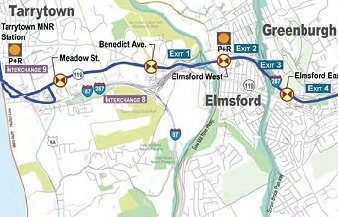
As Hudson Valley and regional elected officials, civic leaders, and citizens have weighed in on the new plans for the Tappan Zee project, the media has done an extensive and accurate job reporting on the broad, vocal support for public transit. However, one piece of commonly reported information is worth a closer look: The claim that transit “could add $10 to $15 billion to the cost of the project,” or that “transit could drive the project cost up to $21 billion.” This phrasing glides over the fact that a cross-corridor bus rapid transit system, which had been planned to open simultaneously with the bridge, would cost much less — about 90% less, in fact.
The “$10 to $15 billion” figure combines the State DOT’s estimated costs for both a bus rapid transit system (from Suffern to Port Chester), and a commuter rail line connecting Rockland County and Grand Central Terminal. The bulk of that cost is for the rail system, which wouldn’t have been built until some future date. According to the agency’s 2009 “Transit Mode Selection Report,” the BRT portion of the project was estimated to cost $900 million to $2.5 billion, depending on how much heavy-duty infrastructure it included.
As Streetsblog’s Noah Kazis wrote earlier this week, saying that a $5.2 billion bridge replacement is affordable, but a $1 billion BRT system is not, is not an objective fact but a statement of the governor’s priorities: “‘Affordable,’ in this case, really just means ‘worth the cost.’ If Cuomo viewed building transit across the Tappan Zee as vital, transit might be ‘affordable’ as well.”
Given the public consensus that transit is vital, and the important economic and environmental benefits it would bring to the Hudson Valley, the Cuomo administration must find a way to make it work. For example, it may be worth taking a second look at the engineering to identify ways to reduce costs without compromising service.
So far, there’s no indication that the administration is interested in doing so. At an October public meeting at the Palisades Center in West Nyack, NYSDOT Commissioner Joan McDonald said a BRT system would cost “two billion to four billion dollars,” but hasn’t really explained how she came to this conclusion. McDonald also claimed that “We’re speeding up construction of the bridge, we’re not slowing down transit.” Given that the new project includes lacks the guarantee of transit the old project deemed necessary, that is simply false.
Image: Via NYSDOT.

Build the rail line from Suffern to White Plains and if possible beyond to a good transfer point on the New Haven line. Use single track capable of supporting 15 minute headways to save money while reserving the right of way for later double tracking. Integrate the bus and rail fares so that there is no penalty for taking the train. Use 750 volts DC 3rd rail, 12,500 volts AC overhead or 25,000 volts AC overhead whichever proves most cost effective including equipment costs. With trains of appropriate length every 15 minutes all day, effective used bus connections that actually will be used become feasible. Anyone who believes that direct buses can effectively serve the diverse origins and destinations also believes in the tooth fairy. Remember that the rail right of way already exists for much of the way between Suffern and the Hudson River. If cheaper use a separate bridge for the rail line. Save money by NOT expanding the highway capacity.
It seems to me that when designing the bridge and its approaches that it would not be all that difficult or expensive to design it so that 1. a 2nd deck can eventually be added, 2. if done that room be left on the approaches for bus lanes and 2 transit tracks. I don’t know if this is the best approach but it certainly seems like it should be viable.
There should be an effort to build both passenger and rail freight bridge, either as part of the Tappan Zee itself if the costs are lower than creating a separate span. The costs of doing this have to be weighed against the costs of doing nothing, or trying to solve the fact that no rail freight can cross the Hudson until going north almost to Albany, and passenger service is only via NJ to Manhattan at this point. Combining it with bus service should be a goal, but running busses over the new bridge should probably just be an interim solution. Money could be saved by not building a Cross Harbor tunnel, which also will cost $$billions, and that project would only expedite freight to Long Island instead of the entire New England area of the Northeast US. Long Island could then be served via the existing Hell Gate bridge, with some less costly improvements. And I fully agree that connecting Suffern-White Plains to the New Haven Line to ease commuting in the region.
I have gone over some of these designs and I’m sure that this project can be done for under $2Billion US. This is with 2 way high speed maglev rail, bus, and toll collection.